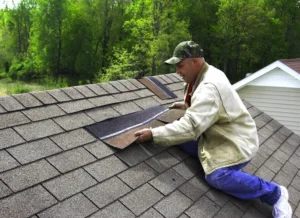How to Avoid Roof Replacement Costs
Roof replacement is one of the most important home repairs you can make. Few things can damage your entire house as quickly as a failing roof.
Depending on the cause, your homeowner’s insurance may cover the roof replacement cost. Here are some of the most common reasons for a roof replacement. For more information, visit this link www.houseexteriorpaintingcv.com.

Your roof’s shingles are its first line of defense against the elements. When shingles are damaged, water can seep into your home and cause serious damage. If you act quickly, you can often save yourself from a costly roof replacement.
Before you begin repairing damaged shingles, it’s important to assess the situation. The damage can be due to various reasons, such as improper installation or wind damage. Sometimes, the issue may be more widespread and require a full roof replacement.
The first thing you should do is make sure the weather is clear. Working in ideal conditions is important so you don’t get wet and cold while working on the roof. Once ready to start, use a ladder to access the damaged shingle area. Depending on how damaged the shingle is, you should clean the area and remove any debris preventing you from accessing the nails holding it.
Once you’ve reached the damaged shingle, use a pry bar to lift the course of the shingles above it. Once the shingle is loose, you can remove the nails that hold it and pull it away. You’ll also want to remove the pins that penetrate the shingle directly above it, as these will likely need to be replaced when you install the new shingle.
Next, you’ll need to find a shingle that closely matches the existing ones. You can search for a shingle that is close in color or take a small section of the damaged shingle as a template. Once you’ve found a replacement, cut it to the exact size with your tinsnips and slide it into a place where the damaged one used to be.
If you have any other loose or cracked shingles, you can repair them by injecting roofing tar beneath them. Be careful not to get too much tar on your roof, which can cause leaks.
If your shingles are damaged and require replacement, you must consult a professional roofer to determine the best way to proceed. A professional can thoroughly inspect the entire roof and recommend any necessary repairs.
An undetected water leak can lead to mold, rotting wood, and ceiling damage. It can also cost you money on your utility bill. When a leak is discovered, it needs to be repaired right away. It’s a good idea to have this done by a professional roofer to make sure it doesn’t lead to further problems and more expensive repairs later on.
The first step to finding the source of a leak is to stop the water flow by turning off all indoor faucets and shutting off your shower, sinks, and dishwasher. This will prevent more water from entering your home and should give you an indication of the location of the leak. The next step is to look for wet spots on the floor or walls.
If you have access to the attic, or if your roof is a flat or dormer style, check the rafters and sheathing for wet areas. This is one of the easiest ways to locate a roof leak. If there are no obvious signs, you can perform a water test, wherein someone outside the house sprays water in different areas while someone inside looks for evidence of dripping and dampness.
Other common locations for roof leaks are the corners of the soffit and the wall, vents, chimneys, and dormers. These leaks often happen when flashing needs to be installed or a roof is old and worn. To fix this, replace the step flashing and apply a new membrane and caulking.
Some roof leaks are caused by shingles that have been improperly staggered. These can drip from the center and go unnoticed for some time. A simple solution is to slide an 8×8 flashing card under the shingle at the edge of the gap.
Other roof leaks can occur because of a poorly installed vent boot, a rusted chimney flashing, or a leaking valley on the roof. These can be easy to fix, but you will need a ladder, roofing materials, and basic skills. If the leak is due to a bad install or a rusted flashing, remove the siding and the shingles in that area and replace the flashing.
Your gutter system helps protect your home’s foundation from water damage by routing rainwater and melting snow off your roof. When clogged or damaged, gutters no longer function properly and can cause severe problems that require costly repairs.
Clogged, misaligned, or sagging gutters allow water to overflow and pummel the soil around your house or infiltrate behind the fascia boards. In addition, pooling water can rust metal gutters or leak through cracks and holes in the gutters.
Loose gutters are another common problem. This can occur when the nails that hold the gutters in place loosen. The gutters can shift and pull away from the house when this happens. Water can also seep into spaces left by the nail holes and rust or rot the fascia boards beneath.
Lastly, gutters can develop holes when they become clogged with leaves and debris or get punctured by falling branches. The holes can become larger over time as the gutters fill with standing water, and the space left by the hole allows more debris to enter the gutter.
A roof often leads to a deteriorating gutter system and serious water damage. To prevent this, inspecting your gutters regularly and performing routine maintenance such as cleaning and repair when needed is important.
If you notice any signs of damage, contact your local roof repair experts for a roofing inspection. The professional roofers can help you determine if your roof needs replacement and if you need to replace your gutters.
Gutters are designed to guide rainwater and melted snow off your roof and into downspouts, directing the water away from your siding and foundation. When your gutters are damaged or in disrepair, the water can no longer be drained and infiltrates behind your home’s siding and into the foundation. This can create various issues, including roof rot, mold in the attic, basement flooding, and landscaping erosion. The solution is to keep your gutters in good condition with regular maintenance and proper installation.
Nothing is more disturbing than hearing random, unexplained noises in your home. This is especially true when these sounds come from the attic, and you think your roof may be about to cave in. These loud noises are usually caused by thermal expansion and contraction of the framing. When the sun is out, it heats the shingles and the underlying structure. During the night, these structures cool down. This causes the lumber to rub against itself, which produces the popping sound that some homeowners hear.
These noises can also be caused by the roofing crew hammering nails on your roof. The banging can be quite loud and echoes through the house. If you work from home, this can be very disruptive. Rescheduling client meetings for this period or taking your laptop to the library is best.
Popping and cracking sounds can also be caused by ice build-up in the attic or snow accumulation on the roof. If you suspect that your roof is experiencing structural problems, it is important to have a professional inspection.
A professional will be able to determine the cause of the problem and make the necessary repairs to your roof. Once the problem is fixed, you can enjoy your roof without fear of it collapsing.
While staying in your home during a roof replacement is possible, the noise can be very disruptive. It would be a good idea to reschedule work and personal appointments for the day of your roof replacement. Consider moving out of your home for the duration of the roof replacement. If you can’t afford to relocate, preparing for the noise is a good idea by covering sensitive items with tarps or painter’s drop sheets. The attic of sentimental and fragile objects should be cleared before starting the job. This will help reduce the dust accumulated during the job and make clean-up easier. By following these tips, you can have a successful and stress-free roof replacement.





